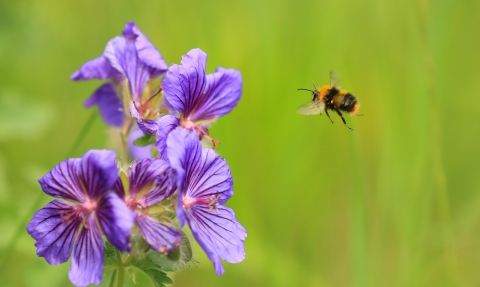
Early bumblebee, Jon Hawkins, Surrey Hills Photography
Bring back bees
Just imagine if everyone in Derbyshire sowed a mini meadow in a corner of every garden/yard this year, what a difference we could collectively make…
Plant your own mini meadow
Plants and flowers that are great for pollinators
Wild plants
• Achillea millefolium (common yarrow)
• Cantaurea scabiosa (greater knapweed)
• Digitalis purpurea (common foxglove)
• Eupatorium cannabinum (hemp agrimony)
• Lonicera periclymenum (common honeysuckle)
• Origanum vulgare (wild marjoram)
• Thymus pulegioides (large thyme)
• Trifolium repens (white clover)
• Verbascum nigrum (dark mullein)
• Viburnum opulus (guelder rose)
Garden plants
• Caryopteris x clandonensis (caryopteris)
• Dianthus barbatus (sweet william)
• Hesperis matronalis (dame’s violet)
• Hyssopus officinalis (hyssop)
• Jasminum officinale (common jasmine)
• Lavandula angustifolia (English lavender)
• Lychnis coronaria (rose campion)
• Monarda didyma (bergamot or bee balm)
• Verbena bonariensis (purple top)
• Weigela florida (weigelia)
Size
Small garden? Don’t worry - you can grow a wild flower meadow in a container pot or a window box. If you have a bigger space, mark out 1m2 of lawn.
Position
Wild flowers meadows grow best in a sunny location. Don’t sow yours in the shade!
Preparation
Test the soil pH by using a simple soil testing kit that you can get from your local garden centre.
High pH = Lots of nutrients and too rich for wild flowers.
Low pH = Low in nutrients but great for wild flowers.
If you are growing your wild flowers meadow in a pot, fill it up with a low nutrient top soil and avoid compost.
For lawns, if the pH is too high remove an inch of soil and replace with a low nutrient top soil. If the pH is already low, stop mowing that area until late August then cut the grass, remove the cuttings and scarify the ground to create bare patches.
Seed
The most important bit is to choose the right seed – make sure it is native and appropriate for where you live. Also ensure you have the correct seed for your soil type.
You can order online from the following companies who supply a good list of seed mixes and advice, and we have had great success with them:
Emorsgate: www.wildseed.co.uk
Naturescape: www.naturescape.co.uk
Landlife: www.wildflower.co.uk
Or visit your local garden centre – they will be happy to help.
Sowing
Sow your mini meadow in April or September.
Use a perennial seed mix to establish it, with typical species like oxeye daisy, knapweed and bird’s-foot-trefoil. Sow the seed at a rate of 2 to 5g per square metre, or use the supplier’s recommendations.
You can either sow with just wild flower seed or with a wild grass/wild flower seed mix. Wild grasses include some attractive species such as red fescue, sweet vernal grass and Yorkshire fog. You can also sow with spring flowers like red campion and cowslip if you prefer a spring flowering meadow.
For containers or high pH soils, try an annual seed mix containing the cornfield annuals such as poppies, cornflowers, corn cockle and corn marigold that were once common in arable fields. You can re-sow this way each year.
Top tip – Sowing yellow rattle will cut down grass growth so your wild flowers will thrive.
When to cut
Watch your meadow grow until, finally, in spring/summer it will be at its finest with a colourful array of flowers, bringing in lots of butterflies, bees and birds.
Then in late August you will need to trim the flowers. It is important to remove the cuttings so you continue to remove nutrients from the container or lawn each year. Keep trimming between August and March and come April, let the flowers flourish.
Don't forget
Make sure you collect seeds from your wild flowers and put in gaps in your pot or lawn to help improve your mini meadow over time.
Make a bee box
Let Nick Baker show you how...
